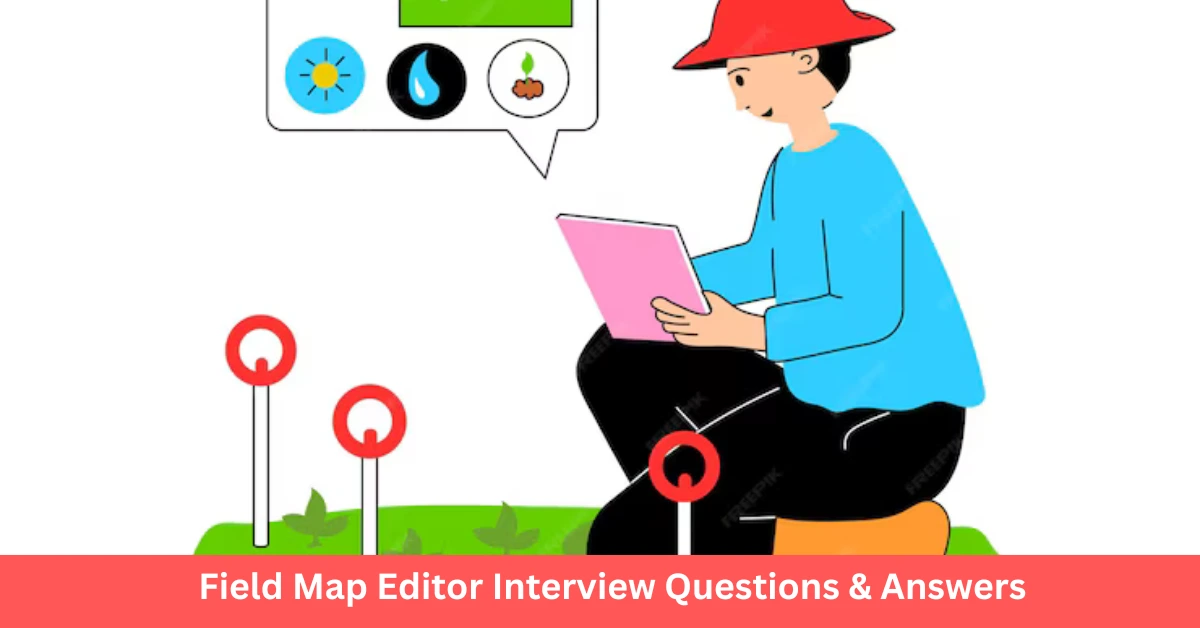A Field Map Editor plays a crucial role in updating, managing, and editing geospatial field data for various applications, including urban planning, agriculture, and environmental studies. If you’re preparing for a Field Map Editor role, this guide will help you excel in your interview by covering the top 15 Field Map Editor Interview Questions & Answers related to the job.
15 Field Map Editor Interview Questions & Answers
Here’s a comprehensive list of 15 Field Map Editor Interview Questions & Answers along with detailed answers to help you prepare and impress your interviewers.
1. What is the role of a Field Map Editor?
Answer:
A Field Map Editor is responsible for collecting, editing, and validating field data to ensure maps are accurate and up-to-date. This includes working with geospatial tools to integrate field observations into digital maps.
2. What tools or software have you used for field map editing?
Answer:
I have experience with:
- ArcGIS Field Maps
- QGIS
- Trimble GPS devices
- Survey123
- Google Earth Pro
3. What is the importance of real-time data collection in field map editing?
Answer:
Real-time data collection ensures that maps reflect the most current information, which is critical for applications like disaster management, navigation, and environmental monitoring.
Related Article: Top 15 Mapper Interview Questions & Answers
4. How do you ensure data accuracy during field map editing?
Answer:
I validate data by:
- Using high-accuracy GPS devices.
- Cross-referencing data with satellite imagery.
- Implementing data validation rules and quality checks.
5. What is geotagging, and how is it useful in field map editing?
Answer:
Geotagging involves attaching geographic coordinates to field data (e.g., photos, observations). It helps accurately place data points on maps for analysis and decision-making.
Related Article: Top 15 LIDAR Technician Interview Questions & Answers
6. How do you handle discrepancies between field data and existing maps?
Answer:
I:
- Identify the source of discrepancies.
- Consult field notes or metadata for clarification.
- Update maps with accurate, verified data.
7. What is your experience with GPS devices for field mapping?
Answer:
I have used devices like Trimble, Garmin, and handheld GNSS receivers for collecting high-precision field data and integrating it into GIS software.
8. What are common challenges in field data collection, and how do you address them?
Answer:
Challenges include poor connectivity, equipment failure, and environmental conditions. I address these by:
- Using offline mapping tools.
- Keeping backup devices.
- Planning fieldwork around weather conditions.
Related Article: 15 Cartographic Drafter Interview Questions and Answers
9. Can you explain the process of creating a field map from scratch?
Answer:
- Define the map’s purpose and scope.
- Collect field data using GPS and surveys.
- Import data into GIS software for processing.
- Edit and validate the data.
- Design and export the final map.
10. What is the role of metadata in field map editing?
Answer:
Metadata provides essential details about data, such as its source, accuracy, collection method, and date. It ensures transparency and reliability in map editing.
Related Article: Top 15 Cadastral Mapper Interview Questions
11. How do you integrate field data with existing geospatial datasets?
Answer:
I use GIS tools to:
- Align coordinate systems.
- Merge datasets based on common attributes.
- Validate the integrity of the integrated data.
12. What is the importance of attribute data in field maps?
Answer:
Attribute data provides context for map features, such as names, categories, or measurements, enabling meaningful analysis and decision-making.
Related Article: 15 Cartographic Designer Interview Questions
13. What methods do you use for quality control in field map editing?
Answer:
I perform quality control by:
- Reviewing data accuracy and completeness.
- Running automated validation checks.
- Comparing data against trusted sources.
14. How do you keep your mapping skills up to date?
Answer:
I stay updated by:
- Attending geospatial workshops and webinars.
- Taking courses on new GIS tools and techniques.
- Participating in field mapping projects.
Related Article: Top 15 Cartography Technician Interview Questions and Answers
15. Can you share a successful field map editing project you worked on?
Answer:
I worked on an agricultural mapping project where I collected and edited field data to create a precision farming map. It helped farmers optimize water usage and improve crop yields by identifying soil health patterns.
Conclusion
A Field Map Editor ensures the accuracy and usability of field data in mapping projects. These top 15 interview questions and answers cover the technical skills and problem-solving approaches needed to excel in this role.
Stay tuned to our blog for more tips and resources for advancing your geospatial career.
